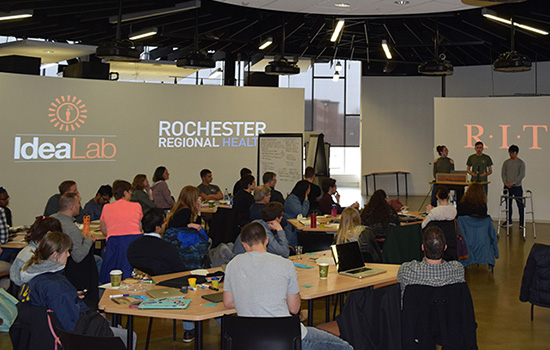IdeaLab teams proposed healthcare solutions
‘Design Thinking’ strategies create innovative solutions to Rochester Regional Health challenges
Maulik Zota
RIT students from a variety of disciplines and faculty mentors participated in IdeaLab@RIT, a bi-annual event that brings together faculty coaches and students from multiple disciplines to work collaboratively on a client organizations’ real-world challenges over the course of a weekend.
RIT student Cole Miller loves diving head-first into big problems and surfacing with possible solutions—which is exactly why he keeps returning to the IdeaLab@RIT.
IdeaLab@RIT is a bi-annual event that brings together faculty coaches and students from multiple disciplines to work collaboratively on a client organization’s real-world challenges over the course of a weekend. Twenty-one RIT students participated in the spring IdeaLab@RIT, which was held March 25-26, and developed possible solutions to challenges provided to them by Rochester Regional Health patients and healthcare personnel.
Here’s what they came up with:
- An environmentally conscious solution that enables the hospital’s medical supply department to dispose of Styrofoam shipping containers by mixing them with acetone and converting them into reusable plastic substances
- A new web portal that redirects behavioral patients to the appropriate care level at the hospital’s Access and Crisis Intervention Center
- A redesign of the interior space of the Evelyn Brandon Health Center with emphasis on a welcoming environment, proper traffic patterns and calming colors and materials that are in line with the center’s purpose
- An online user-centered system design called “IseeU” Connected Care for connecting ICU patients with loved ones and re-personifying patients with their caregivers
- A device enabling individuals with physical limitations to work with their physical therapists to track and measure physical activity progress. The device would be mounted on a walker and use a Bluetooth-enabled system to display information on smart phones or other devices.
“In order to provide possible solutions to the challenges brought to us by Rochester Regional Health, our faculty coaches and students used Design Thinking methodology, a human-centered approach to innovation that considers user needs, technology possibilities and business requirements as fundamental components for creating value,” said Dan Harel, adjunct professor of industrial design and IdeaLab lead.
Harel also said the event is a collaborative multidisciplinary effort within all of the RIT colleges. This cohort featured students studying industrial design, interior design, mechanical engineering, biomedical engineering, computer science, business, networking and systems administration and industrial engineering.
The IdeaLab began as a successful pilot program in 2013 in the Albert J. Simone Center for Student Innovation and Entrepreneurship, and since then, several of the past student entrepreneurial projects have advanced into real product solutions and businesses.
In 2015, Nora Manzella’s IdeaLab team was tasked with designing a more efficient dynamic arm support system for people with muscular dystrophy. After the weekend, she was able to continue developing the project through independent study.
“I had the chance to work more closely with my team and develop our product further,” said Manzella, a third-year industrial design student from Silver Spring, Md. “We also had the chance to visit the facilities and meet the people we were designing for. And at the end of the semester, the responsibilities of the project were transferred to another class so the work could continue further. I think we all learned something from people of other disciplines, and from people in our own majors with more experience. I am so grateful for the experience I have had.”
Manzella also participated in the most recent edition of IdeaLab.
“I also learned that I’m pretty interested in medical design,” she added. “I enjoy the research that comes with it and I really like working on projects that have the potential to impact someone’s life. I plan to keep this in mind as I move forward with my studies and have more opportunities to apply my own interests to my projects.”
Miller, a second-year biomedical engineering student from Chicago, sees IdeaLab as an opportunity to grow as a student.
“Idea Lab gives me a benchmark to see how far I’ve drifted from the person I was when I came to RIT as well as a milestone, demonstrating how much I’ve learned and am able to apply my new skills to meaningful problems.”




